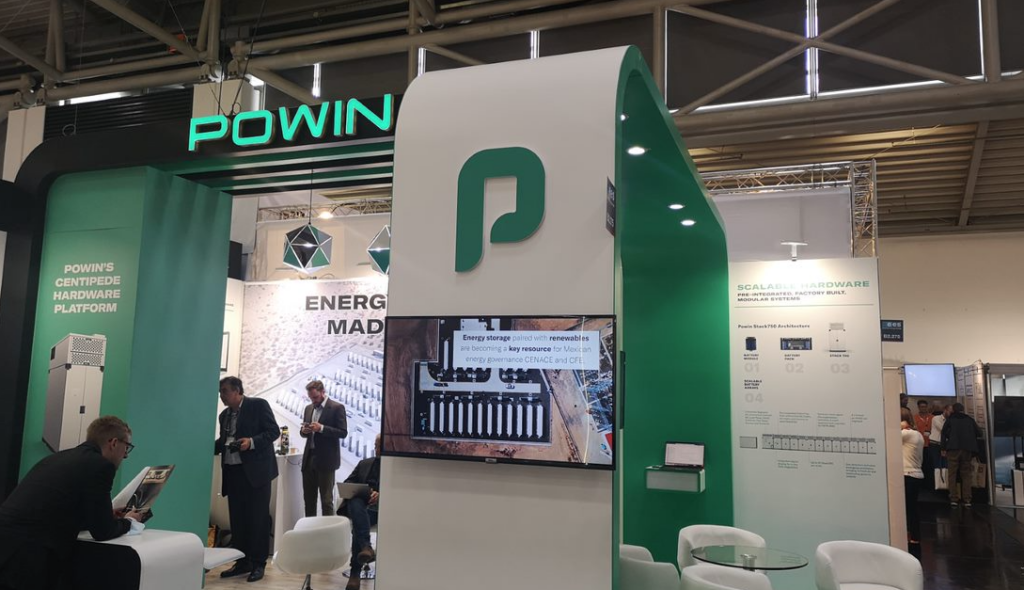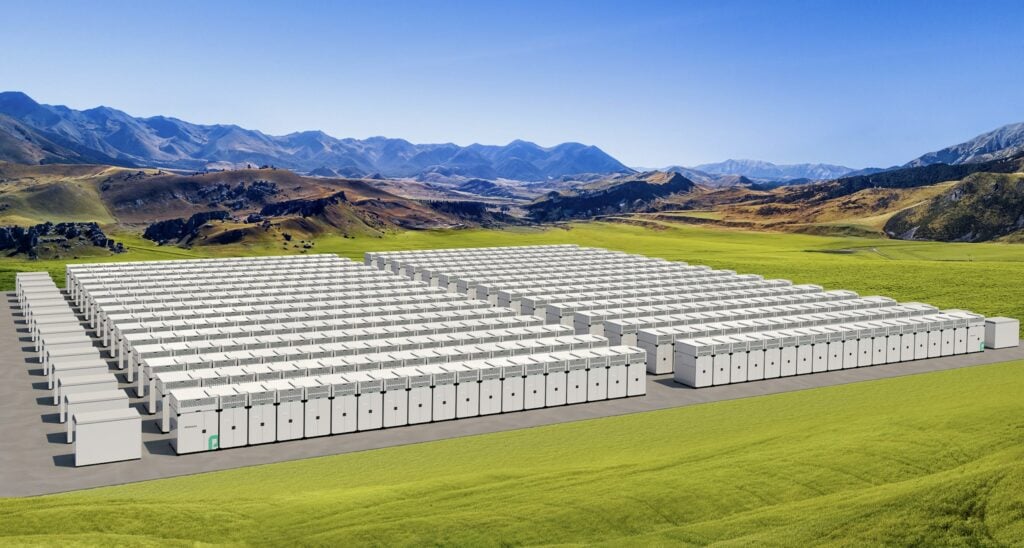
Geoff Brown, CEO of the the world’s fifth largest battery energy storage system (BESS) integrator Powin Energy, discusses the company’s strategy for the coming years in an interview with Energy-Storage.news.
The Portland-based company had a 5% market share of the global BESS system integration market last year, according to IHS Markit. But it is one of only three in the top 10, along with Fluence and FlexGen, that is a pure BESS system integrator play and has to-date deployed over 2GWh of projects, mainly in the US. Last year, it was acquired by private equity firms Trilantic and Energy Impact Partners.
Enjoy 12 months of exclusive analysis
- Regular insight and analysis of the industry’s biggest developments
- In-depth interviews with the industry’s leading figures
- Annual digital subscription to the PV Tech Power journal
- Discounts on Solar Media’s portfolio of events, in-person and virtual
In this interview, CEO Geoff Brown discusses the company’s manufacturing strategy, diversifying its software platform to cover co-located storage sites, diversifying its supply chain away and Powin’s approach to non-lithium-ion chemistries.
Supply chain has become a big theme in the sector in recent quarters for obvious reasons, and the company has taken several steps to mitigate against constraints both near and long-term. This includes a large offtake agreement with Norwegian lithium-ion gigafactory strartup FREYR and moving its assembly production closer to the US through a deal with multinational electronics manufacturing services Celestica, in Mexico.
Energy-Storage.news: Talk us through the assembly production strategy and how many more manufacturing facilities you are planning to contract with, and where?
Geoff Brown: Everybody has seen the logistics and shipping challenges over the last 18 months which have of course increased cost but also affected our ability to ensure on-time deliveries. Things are a lot easier when you’re able to basically eliminate the oceanic shipping transportations from finished goods to customers.
So we are looking at doing similar OEM manufacturing partnerships in other regions of the US to bring that final goods assembly closer to centres of demand. We’re not ready to announce where they might be but we’re actively involved in dialogues with multiple OEMs, including Celestica which has an international factory network that we would be able to leverage for some of our international projects. We expect 50% of our demand is going to be international by the middle of this decade.
How do you see your software platform evolving over the next few years?
We really see a future where the hardware is sold part-and-parcel with the software. The nature of an energy storage product is that it is continuously dispatched and continuously monitored. The software platform therefore needs to have a best-in-class powerplant controller status system like we have with StackOS but also close inter-tie with the utilities, controls and operating network and automatic dispatch market optimisation algorithms which are all going to be a central part of that platform.
I think we’re 50% of the way along that journey. We’ve got some really interesting partnerships in development that we’re not quite ready to talk about but that are really going to be a significant step forward for us on that side, as well as developing some of these capabilities organically. We have a very active and growing software team.

You can’t just think about it as an optimisation platform but also you need to think about the user experience for simple things like preventative maintenance, automated reporting and using data to make better decisions.
Being a specialised battery storage solution provider is a plus but with the amount of storage pipeline that is co-located, doesn’t that software platform really need to cover other renewables too?
I couldn’t agree more and doing that is absolutely part of the journey I mentioned earlier. We think that the future is a world where battery integrators like ourselves are not just selling a storage component of a larger system but we are the core provider of dispatchable renewable energy assets.
So that could be a solar-plus-storage site controlled by a single power plant controller where the storage is used as the capacity component of the renewable resource. And there is an intelligent optimised power plant controller that both runs the power plant, runs the trackers, monitors the PV inverters, monitors the storage and storage PCS (power conversion system) in a way that best matches the desired use case of the investor and utility.
I think the way that it’s currently being done is relatively balkanised with too many different individual technology providers. It works, and it works well in most cases, but it’s a little bit clunky, and the companies that are going to lead this industry in the back half of this decade are going to be ones that are going to be able to integrate it into a whole platform.
Could you really achieve this in-house/organically alone?
We’re evaluating all options but I would not necessarily agree that it’s a necessity to do it inorganically. A lot of the core capabilities that we have built to run our storage asset are directly applicable, both from a code base perspective and from an understanding and team capability perspective.
Tell us about your supply chain exposure to China and whether you have concrete aims to reduce this over time?
From a numbers perspective, an overwhelming majority of the components assembled at our Celestica plant in Mexico are of non-China origin. But by far the most expensive component is the battery cell and for battery cells right now, there is one place on the planet to get lithium iron phosphate (LFP) batteries of any magnitude in terms of volume and that’s China, so we don’t have any other source for the next 24 months.
But we are actively working both with our Chinese based OEM manufacturers to open manufacturing in other geographies as well as alternate cell suppliers that are working very hard to build robust cell manufacturing supply chains elsewhere. We just announced a super exciting partnership with FREYR for the back half of this decade for some very large volumes as they’re ramping up their manufacturing capacity.
We’re in this business because we believe LFP and lithium batteries more broadly are going to be an essential, critical part of the world’s journey away from fossil fuels. I think already from a performance and a safety perspective, it is much better than the incumbent technologies and now it’s just a question of building the underlying manufacturing capability to allow that future to come into being.
We are big supporters of diversifying the manufacturing base and big supporters of diversifying the raw material base. Importantly, it takes time. And I think the right approach is to engage support from multiple different geographies but continue to engage with China as a primary place because there’s a lot to do in just the next couple years and we’re really eager to be building these projects.
How do you balance the need for your suppliers to have a strong track record with using new players from the US and Europe that maybe don’t have that track record?
Obviously, there’s a big difference between new technology and new companies. I think one of Powin’s initial insights was that there are new chemistries and new variants of lithium-ion batteries that are in the market all the time but that there are also some very, very well understood tried and true chemistries LFP in particular whose safety and long term performance is well demonstrated. And the manufacturing process is well-understood and importantly not controlled by a single company.
And so when we look at when we look at an individual cell manufacturer, they could be a relatively new incumbent but they could easily have a manufacturing process that we’re familiar with. We have both our team and through our consultant network an extended auditing capability to really understand the manufacturing base. We are eager to support, understand and engage with new companies that are using established chemistry.
Powin has also invested significantly in our battery lab based here in Oregon. We want this to really be the premier independent battery testing facility, and I say independent because we work with lots of different cell manufacturers, and run their cells through a number of different capacity and degradation and other types of characterisation activities, understanding the safety of each of them, and that helps us to understand not only where we’re going to take our products, but also the direction and improvement in the overall science of batteries.
We are expecting that, just like you’ve seen in the PV space, there’ll be steady but significant improvement in the underlying capacity and performance of the batteries as all these manufacturers work to improve. And we want to be here to be able to help them along the way integrate it when appropriate into the utility scale product and really being able to, as leaders are identified, help to bring them to our customers.

You’ve mentioned a few times lithium-ion, but specifically LFP, being the best solution out there. Once we start to see increased durations would you consider other technologies too?
Absolutely and that’s why I referenced the battery lab. That lab is sort of the tip of our spear as we start to engage with new companies and new product manufacturers. If the product is safe, and it performs, and we see that it’s really viable both from a performance as well as from an LCOE (levelised cost of energy) perspective then absolutely, why not?
We take a really rational measurement-based market-driven approach to it. We try not to fall in love with a particular chemistry. We are not battery people, we’re power plant people and we want to bring the potential of lithium-ion chemistry to the utility-scale space and as the best chemistry changes so we’ll adapt our product accordingly. Currently, it’s pretty clearly LFP by a wide margin, so that’s why we’re LFP. I don’t expect I will be saying the same thing 10 years from now.
Have you brought in any raw material index (RMI) pricing into your contracts to hedge against the price volatility we’ve seen recently?
I’m not going to talk about our under NDA pricing with our customers. There are a lot of different ways that we’re working with both our vendors and our customers to mitigate the current commodity price increase. And some of them are indexed if that’s the right approach for all parties and if not, we have other approaches as well.
Any other strategic priorities for the coming 3-5 years, and has any of this changed under the new ownership?
A lot has changed since the takeover, but I would argue our strategy has not changed in nearly five years.
Powin is not a battery chemistry company, we are a platform company. We are focused on trying to build the best hardware and software platform that can deliver dispatchable renewable energy. It’s our job to continue to invest in the product, expand the platform’s capabilities to ensure we can deliver a comprehensive cell-to-system all the way to the largest utility and power plant developers.
That means closer and closer involvement with power electronics and solar and wind, investments in software and usability, and continued investments in our service and maintenance capability. We think the best way to encourage and drive the energy transformation is through continuing to develop the best-in-class solution and at a very competitive cost point.

